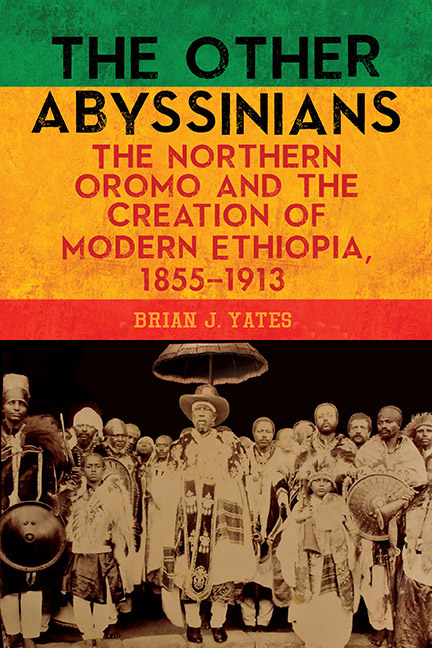Book contents
- Frontmatter
- Contents
- Preface
- Introduction: What about the Oromo Habäsha? Liberating Northern Oromo Experience from Competing Nationalisms
- 1 Cultural Backgrounds and the Habäsha State
- 2 In but not of: The (Re)Integration of the Wällo Oromo into the Habäsha Community
- 3 Menilek, Gobäna, and the Creation of Habäsha Shäwa, 1855–88
- 4 Recreating the Autonomy of Wällo: The Unions of Mikaél and Menilek
- 5 From Personal Relationships to a Centralizing State: Shäwan Ethiopia (1889–1913)
- Conclusion: The Oromo Habäsha in Modern Ethiopia
- Appendix A Guide to the Transliteration of the Ethiopic Script to the Latin Script
- Appendix B Glossary of Ethiopian Terms
- Appendix C Sample Interview Questions for Shäwa and Wällo
- Notes
- Bibliography
- Index
Introduction: What about the Oromo Habäsha? Liberating Northern Oromo Experience from Competing Nationalisms
Published online by Cambridge University Press: 21 March 2020
- Frontmatter
- Contents
- Preface
- Introduction: What about the Oromo Habäsha? Liberating Northern Oromo Experience from Competing Nationalisms
- 1 Cultural Backgrounds and the Habäsha State
- 2 In but not of: The (Re)Integration of the Wällo Oromo into the Habäsha Community
- 3 Menilek, Gobäna, and the Creation of Habäsha Shäwa, 1855–88
- 4 Recreating the Autonomy of Wällo: The Unions of Mikaél and Menilek
- 5 From Personal Relationships to a Centralizing State: Shäwan Ethiopia (1889–1913)
- Conclusion: The Oromo Habäsha in Modern Ethiopia
- Appendix A Guide to the Transliteration of the Ethiopic Script to the Latin Script
- Appendix B Glossary of Ethiopian Terms
- Appendix C Sample Interview Questions for Shäwa and Wällo
- Notes
- Bibliography
- Index
Summary
History lost is history not sought.
—Oromo ProverbAt the turn of the century, Menilek II (r. 1888–1913) of Shäwa, the Ethiopian emperor, named his grandson Iyasu (r. 1913–16) as his heir and successor. On the surface, this was another in a long line of passages of authority from the male descendants of Solomon; however, just below this surface, it was the culmination of decades of intermarriage, acculturation, and negotiation that marked the modern Ethiopian state. Decades before, both Menilek II's Shäwa and Iyasu's Wällo were semi-autonomous provinces. The last half of the nineteenth century is defined by the utilization of cultural practices and shared history that bridged religious, political, and ethnic boundaries, which created the modern Habäsha community. Habäsha is a term utilized by both Ethiopians and outsiders to describe the diverse populations of Ethiopia, from which the name of the nation, Abyssinia, was derived. I define it in three ways. One, Habäsha individuals must have a knowledge of Amharic; but generally, Ethiopians, like most Africans, speak more than one language. Two, they are generally Christian, but there are a few Muslim exceptions. Three, they must practice Habäsha norms, such as marriage practices and philosophies on lineage and land tenure, such as rest and gult.1 This term, in the scholarly literature, is applied to the Amhara, Tigrinya, and Agaw—but not to the Northern Oromo, who have had a presence in the highlands and have been a powerful force in all aspects of this civilization for centuries. This group has been neglected in order to preserve singular and ahistorical conceptions of the Oromo and Ethiopia. Positing them as Habäsha will result in a clearer view not only of the Ethiopian past, but of the collective Habäsha community that created modern Ethiopia.
The Ethiopia that existed in 1844 when Sahlä Mariyam (Menilek II’s birthname) was born remained fiercely provincial, and it is a distinct Shäwan culture that marks both this province and the empire that expanded from it in late nineteenth century Ethiopia. The forces of the Zämänä Mäsafent included political marriages, alliances that transcended provinces, Habäsha cultural practices, military force, local legitimacy, and conversions to state religions, which became the key tools of Menilek's rise to power.
- Type
- Chapter
- Information
- The Other AbyssiniansThe Northern Oromo and the Creation of Modern Ethiopia, 1855-1913, pp. 1 - 16Publisher: Boydell & BrewerPrint publication year: 2020



